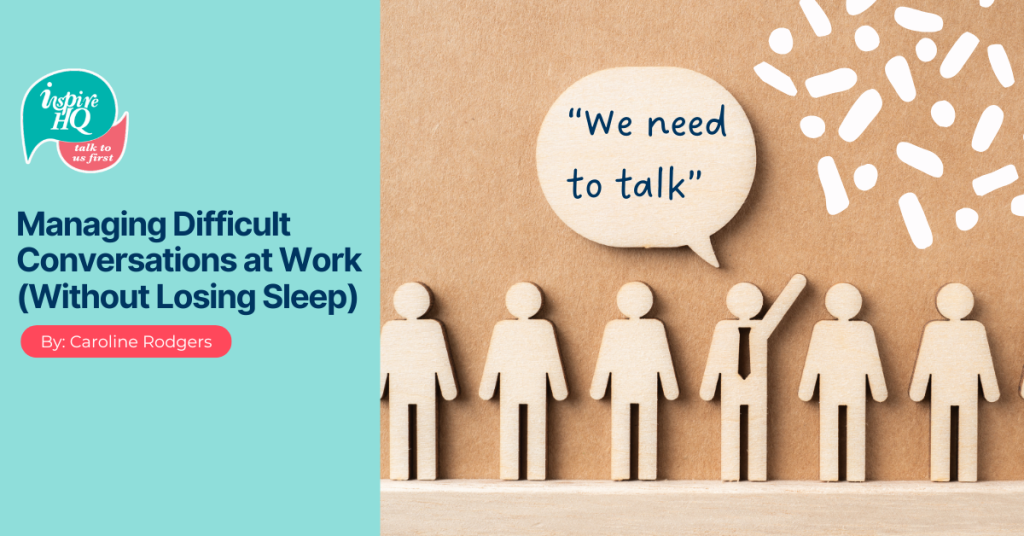Ah, the dreaded difficult conversation. Whether it’s giving constructive feedback, addressing a conflict, or navigating a sensitive issue, these workplace chats can make even the most confident professional want to crawl under their desk.
It might seem easier to avoid the issue and hope it resolves on its own—but avoidance usually makes things worse.
The good news? With a bit of preparation and the right mindset, these conversations can be productive, respectful, and— believe it or not – relationship-strengthening. No need for storming out, silent treatment, or awkward staff-room encounters afterwards!
Let’s break it down into the three key steps: Planning the conversation, having the conversation, and following up.
Step 1: Plan Like a Pro (Without Overthinking It)
Before diving in, take a few moments to prepare. No need for a 37-slide PowerPoint—just a few thoughtful notes will do.
- Know your “why”:
What’s the purpose of the conversation? Be clear on what you’re trying to achieve. (Hint: “making them feel bad” isn’t a goal.)
- Stick to the facts:
Focus on what you’ve observed, not what you’re feeling.
Instead of “You’re always late”, try “I noticed you arrived after 10 a.m. three times this week.”
- Anticipate reactions:
Consider how the other person might feel or respond. Planning for pushback or surprise shows empathy and helps you stay grounded.
- Pick the right time and place:
A quiet meeting room vs the hallway during a coffee break? The latter is doomed to fail every time. Make sure the conversation is private and choose a time when neither of you is rushed or stressed – maybe avoid Monday mornings and late Friday afternoons.
Step 2: Having the Conversation (Take a Deep Breath—You’ve Got This)
Now comes the part that can feel uncomfortable. The part where you actually need to talk about the issue. Here’s how to do it with respect, clarity, and empathy.
- Start with good intent and set the tone:
A simple “I wanted to talk with you about something that I think will help us work better together” sets a collaborative tone.
- Be direct, but kind:
Sugarcoating leads to confusion. Be honest, but not harsh. Think firm but fair—like a good cup of coffee.
- Listen – really listen:
Don’t just wait for your turn to speak. Really listen and absorb what they have to say, and show genuine interest in their perspective. You might learn something new that changes your own views.
- Stay calm and focused:
If things get tense, breathe. Don’t take the bait on drama or defensiveness. You’re here to solve a problem, not win a debate.
- End with action and next steps:
Don’t leave things hanging. Clarify any agreements, next steps, or follow-ups. Even something small like, “Let’s check in next week,” helps.
Step 3: Follow-Up Without Making It Awkward
The conversation might be over, but the work isn’t done just yet. A thoughtful follow-up shows you care and reinforces accountability.
- Check in:
A quick message or casual chat helps keep the door open and shows support.
- Acknowledge progress:
If things improve, say so. Positive reinforcement isn’t just for puppies – it builds trust.
- Keep communication open:
Let them know they can come to you with any questions or concerns. One conversation shouldn’t be the end of the dialogue.
General Tips to Make Difficult Conversations More Comfortable
Okay, “comfortable” might be a stretch. But the following tips can make the process more manageable and certainly a lot less painful – for all concerned:
- Be human:
It’s okay to acknowledge that the conversation might feel awkward or tough. Honesty helps to build connections.
- Use “I” statements:
These are less accusatory than “you” statements. “I’m concerned about missed deadlines” is easier to hear than “You’re not doing your job.”
- Bring empathy:
You don’t always know what’s going on in someone else’s world. A little compassion goes a long way.
- Keep it private – always:
Public call-outs damage trust and morale. Always handle these chats behind closed doors.
Final Thoughts
Difficult workplace conversations aren’t fun—but they are necessary. Handled well, they can lead to stronger relationships, clearer expectations, and a healthier workplace culture.
Remember: you’re not the only one who finds these talks tricky. Everyone’s learning. Everyone’s human.
So next time you feel that knot in your stomach about a tough chat, take a deep breath, make a plan, and lean in.
You might be surprised at how well it goes.


